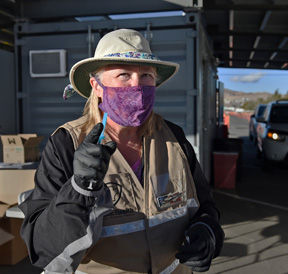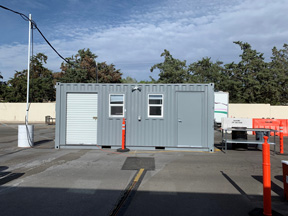Teri

Photo by Andy Barron
During 52 shifts vaccinating people for COVID-19 at the Reno Livestock Arena in Nevada, Dr. Teri Ann Oursler went from being nervous working on human patients to making them laugh and relax. Most of them, anyway.
 Listen to this story.
Listen to this story.
I've been vaccinating people in Nevada for COVID-19 since Jan. 12. Like with all things COVID, I feel as though I started yesterday and 500 years ago.
At first, I was the only veterinarian at the drive-up location in Reno giving shots to the only species my profession does not treat. Eventually, more veterinarians appeared. I'm sure they heard some of the same reactions that I did:
- "I'm good with a veterinarian doing it as long as I'm not getting neutered."
- "Do I also get a tummy rub?"
- "Do I need a cone of shame?"
- "Do I get a treat?" (I wish I could have handed out miniature peanut butter cups but alas, that was not to be.)
- A bark, meow, whinny or moo. One guy's "moo" was so good, I actually looked around for a cow.
A fellow back for his second dose quipped, when asked how his first dose went, "I was vaccinated by a veterinarian. Everything was fine; I only barked for a week." I love people with a sense of humor!
Shortly after I started this volunteer gig in January, I wrote about why and how I signed up, how I got over my jitters and how I learned to help people relax for their shot.
At the outset, folks were excited to get vaccinated. One evening in early February, we inoculated 1,400 educators. They were so grateful. One woman told the traffic controller that she loved me, as I actually made getting the vaccine fun. That made me smile.
As we worked through the tiers of eligible people, following the U.S. Centers for Disease Control and Prevention recommendations, our clientele shifted from the over-75 crowd to 12-year-olds.
Connex

Photo by Dr. Teri Ann Oursler
A connex, ordinarily used by the U.S. Army to ship supplies to overseas bases, was repurposed for the mass vaccination effort.
As the shift occurred, in general, the people coming in went from being eager to being scared. While my vaccinations never made anyone cry, several arrived already in tears. One young lady went from crying to laughing when she realized that I had given her the shot without her noticing. Her eyes wide with amazement, she exclaimed, “You distracted me!”
It was a lot easier to distract her than it ever was to distract a terrified dog patient eyeballing me and my syringe — dogs never laughed at my lame jokes!
I had one 12-year-old boy who came in very fearful and fighting as hard as any cat or dog I had ever seen. It did not help that his little sister was sitting next to him chanting, "Don't do it, don't do it." Neither his mother, me, nor any of the nurses could calm him enough to get the vaccine into his arm. After holding up the line of cars for five or so minutes, his mom gave up and took him home.
In a similar vein, I've seen a lot of women coming to be vaccinated riding in vehicles driven by men with glowers on their unmasked faces. I have had to ask more and more people to put on their mask, as it is not possible to practice social distancing when your head is in your patient's car.
One gentleman in his mid-50s driving a Jaguar decided in the three minutes between check-in and vaccination to refuse the shot. He said his wife called and told him not to get it. He said it was not worth arguing with her.
Thoughts for those with shots pending
- For your second dose, don't forget to bring your vaccine card. As a whole, the group that was the worst about this were the educators. It was all I could do not to ask them if their dog ate it.
- If you faint at the sight of needles, have someone else drive. I saw two drivers faint. The corollary is to make sure the car is in park before any needles are inserted.
- Dress so that your upper arm is reasonably accessible. I have witnessed a lot of wardrobe failures as people came wearing non-stretchy button-down collared shirts and several layers of coats. (Warmer weather will probably help.)
The misinformation being repeated and causing angst makes me sad. Making people unnecessarily fearful is wrong, and it makes a frightening situation worse. Let me state in no uncertain terms:
- There are no microchips in the vaccine. I know what microchips look like, and even the smallest ones are too large to go through these tiny needles.
- The vaccine does not have pieces of human embryo in it.
- The vaccine will not give you COVID.
- The vaccine will not alter your DNA.
- Getting vaccinated if you have already had COVID is not dangerous.
- Natural infection with COVID does not give better immunity than vaccine-induced immunity.
I remain astounded at how truth can be twisted by fear.
I am even more astounded by all the good people in this world. So many stepped up to help with the massive vaccination effort: Retired and currently working nurses, MDs, dentists, pharmacists, pharmacy technicians, veterinarians and veterinary technicians, all helping. There were also many deployed by the National Guard.
Because the Federal Emergency Management Agency deployed workers from all over the U.S., I met 10 U.S. Department of Agriculture veterinarians, including a classmate I had not seen since our 1993 graduation. EMTs and nurses from the U.S. Forest Service and Bureau of Land Management, as well as Veterans Administration nurses, also joined us in Reno.
I learned that organization is everything! Having a plan in place and being able to work the plan makes all the difference in this kind of mega-operation. I cannot say enough good things about Washoe County Public Health. They worked their plan, and most importantly, they have tweaked it every day to make it better.
Pharmacists spend hours drawing up syringe after syringe of vaccine, taking care to mix carefully, pull out the air bubbles, etc. They stand for hours in one place, something that kills my body! And they coordinate closely with each other toward the end of each shift to avoid wasting even one dose of that precious liquid.
The support crew is indispensable. Assistants fill out interminable vaccine cards and paperwork. Penmanship varies wildly, and I am thankful no one has asked me to write anything.
Traffic directors are amazingly good at keeping all of us safe. I had a couple of close calls. Once, I asked a driver if it was OK to step in front of his car. He nodded yes, and then distractedly pulled forward just as I stepped in front. TJ, one of the traffic controllers, got the driver to stop before any damage was done. Another time, another vaccinator and I were inoculating the driver and passenger at the same time. After her shot, the driver started to pull away with my head still in her car, vaccinating her husband.
Besides bringing a (low) risk of being run over, the vaccinator gig can make you hoarse, talking to people all day through double masks. It also requires an ability to handle all types of weather. I typically bring five layers of clothing. I needed the fifth layer twice when the wind was particularly vicious. I am not heat tolerant, so am not sure how many warm days I can volunteer because seeing someone faint from heat scares people, and there is a limit to how many layers one can take off in public!
Since I started vaccinating, I have taken only two weekends off. In all, I have worked 52 shifts on 44 days; eight were double shifts of 10½ hours. Going in and out of the connex, the metal cargo container serving as the temporary hub of activity, is a much better workout than any step routine in a gym.
The job has been immensely satisfying and tiring. Because the site where I've been working will no longer be vaccinating on Saturdays (I worked the last one this weekend), I may have only a rare opportunity to take another shift. I will miss the work and the people I have worked with. I am grateful to have had the chance to make even a small difference in this pandemic.
About the author: Dr. Teri Ann Oursler is a graduate of Colorado State University, where she earned her DVM. She is retired from practice after working 19 years in small animal medicine in Powell, Wyoming. Now she works for the Veterinary Information Network, helping veterinarians find information for their cases. She resides with her husband, one dog and two cats in northern Nevada. She misses her Wyoming friends and mountains.